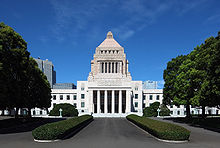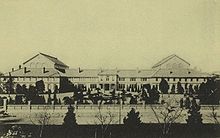- National Diet Building
-
The National Diet Building (国会議事堂 Kokkai-gijidō) is the place where both houses of the Diet of Japan meet. It is located at 1-chome, Nagatachō, Chiyoda, Tokyo.
Sessions of the House of Representatives take place in the left wing and sessions of the House of Councillors in the right wing.
The Diet Building was completed in 1936 and is constructed purely out of Japanese building materials, with the exception of the stained glass, door locks, and pneumatic tube system.
Contents
History
The construction of the building for the old Imperial Diet began in 1920; however, plans for the building date back to the late 1880s. The Diet met in temporary structures for the first fifty years of its existence because there was no agreement over what form its building should take.
Early designs
German architects Wilhelm Böckmann and Hermann Ende were invited to Tokyo in 1886 and 1887, respectively. They drew up two plans for a Diet building. Böckmann's initial plan was a masonry structure with a dome and flanking wings, similar to other legislatures of the era, which would form the core of a large "government ring" south of the Imperial Palace. However, at the time there was public resistance in Japan to Foreign Minister Inoue Kaoru's internationalist policies, and so the architects submitted a more "Japanese" design as well, substituting traditional Japanese architectural features for many parts of the building. Ende and Böckmann's Diet Building was never built, but their other "government ring" designs were used for the Tokyo District Court and Ministry of Justice buildings.
In 1898, Prime Minister Itō Hirobumi interviewed American Ralph Adams Cram, who proposed a more "Oriental" design for the building, featuring tiled roofs and a large enclosure of walls and gates. The Itō government fell as Cram was en route to the United States, and the project was dropped.
First building (1890) and second building (1891)
With an internal deadline approaching, the government enlisted Ende and Böckmann associate Adolph Stegmueller and Japanese architect Yoshii Shigenori to design a temporary structure. The building, a two-story, European-style wooden structure, opened in November 1890 on a site in Hibiya.
An electrical fire burned down the first building in January 1891, only two months later. Another Ende and Böckmann associate, Oscar Tietze, joined Yoshii to design its replacement. The second building was larger than the first, but followed a similar design: it housed the Diet until 1925.
Current building
In 1910, the Finance Ministry started a commission in an attempt to take control over the new Diet Building design from the Home Ministry. Prime Minister Katsura Tarō chaired the commission, which recommended that the new building emulate an Italian Renaissance architectural style. This recommendation was criticized by many who thought that choice to be too arbitrary.
The ministry sponsored a public design competition in 1918, and 118 designs were submitted for the new building. The first prize winner, Watanabe Fukuzo, produced a design similar to Ende and Bockmann's.
The Diet Building was eventually constructed with a floor plan based on Watanabe's entry. The roof and tower of the building were inspired by another entrant, third prize winner Takeuchi Shinshichi, and are believed to have been chosen because they reflected a more modern hybrid architecture than the purely European and East Asian designs proposed by other architects.
Further reading
- Reynolds, Jonathan M. "Japan's Imperial Diet Building: debate over construction of a national identity." Art Journal, September 22, 1996.
See also
Coordinates: 35°40′33″N 139°44′41″E / 35.67571°N 139.74481°E
Categories:- Buildings and structures in Tokyo
- Government of Japan
- Government buildings in Japan
- Chiyoda, Tokyo
- Buildings and structures completed in 1936
- Seats of national legislatures
- Diet of Japan
Wikimedia Foundation. 2010.




